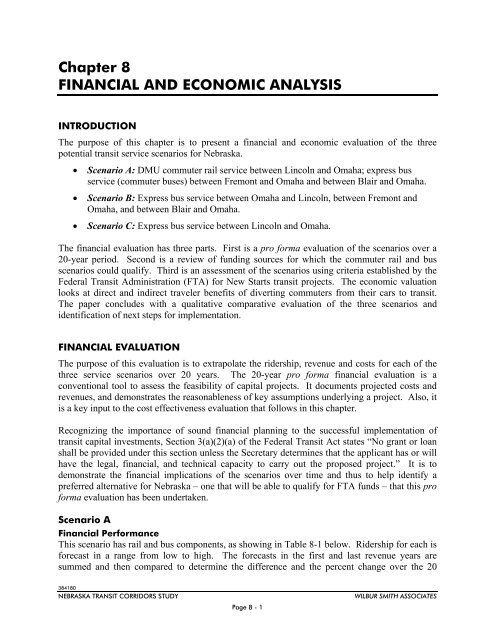NTRAC Final Study - Nebraska Department of Roads - State of ...
NTRAC Final Study - Nebraska Department of Roads - State of ...
NTRAC Final Study - Nebraska Department of Roads - State of ...
You also want an ePaper? Increase the reach of your titles
YUMPU automatically turns print PDFs into web optimized ePapers that Google loves.
Chapter 8<br />
FINANCIAL AND ECONOMIC ANALYSIS<br />
INTRODUCTION<br />
The purpose <strong>of</strong> this chapter is to present a financial and economic evaluation <strong>of</strong> the three<br />
potential transit service scenarios for <strong>Nebraska</strong>.<br />
<br />
<br />
<br />
Scenario A: DMU commuter rail service between Lincoln and Omaha; express bus<br />
service (commuter buses) between Fremont and Omaha and between Blair and Omaha.<br />
Scenario B: Express bus service between Omaha and Lincoln, between Fremont and<br />
Omaha, and between Blair and Omaha.<br />
Scenario C: Express bus service between Lincoln and Omaha.<br />
The financial evaluation has three parts. First is a pro forma evaluation <strong>of</strong> the scenarios over a<br />
20-year period. Second is a review <strong>of</strong> funding sources for which the commuter rail and bus<br />
scenarios could qualify. Third is an assessment <strong>of</strong> the scenarios using criteria established by the<br />
Federal Transit Administration (FTA) for New Starts transit projects. The economic valuation<br />
looks at direct and indirect traveler benefits <strong>of</strong> diverting commuters from their cars to transit.<br />
The paper concludes with a qualitative comparative evaluation <strong>of</strong> the three scenarios and<br />
identification <strong>of</strong> next steps for implementation.<br />
FINANCIAL EVALUATION<br />
The purpose <strong>of</strong> this evaluation is to extrapolate the ridership, revenue and costs for each <strong>of</strong> the<br />
three service scenarios over 20 years. The 20-year pro forma financial evaluation is a<br />
conventional tool to assess the feasibility <strong>of</strong> capital projects. It documents projected costs and<br />
revenues, and demonstrates the reasonableness <strong>of</strong> key assumptions underlying a project. Also, it<br />
is a key input to the cost effectiveness evaluation that follows in this chapter.<br />
Recognizing the importance <strong>of</strong> sound financial planning to the successful implementation <strong>of</strong><br />
transit capital investments, Section 3(a)(2)(a) <strong>of</strong> the Federal Transit Act states “No grant or loan<br />
shall be provided under this section unless the Secretary determines that the applicant has or will<br />
have the legal, financial, and technical capacity to carry out the proposed project.” It is to<br />
demonstrate the financial implications <strong>of</strong> the scenarios over time and thus to help identify a<br />
preferred alternative for <strong>Nebraska</strong> – one that will be able to qualify for FTA funds – that this pro<br />
forma evaluation has been undertaken.<br />
Scenario A<br />
Financial Performance<br />
This scenario has rail and bus components, as showing in Table 8-1 below. Ridership for each is<br />
forecast in a range from low to high. The forecasts in the first and last revenue years are<br />
summed and then compared to determine the difference and the percent change over the 20<br />
384180<br />
NEBRASKA TRANSIT CORRIDORS STUDY<br />
Page 8 - 1<br />
WILBUR SMITH ASSOCIATES

















